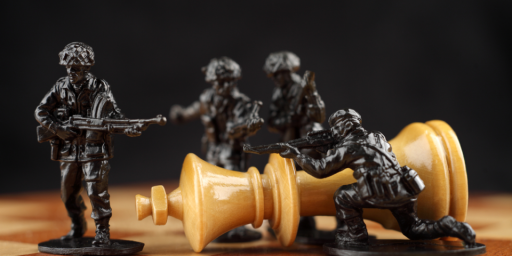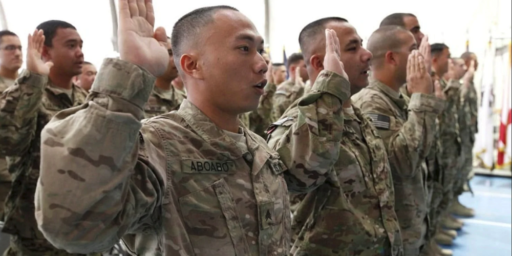OFFICER BLOAT?
ARMY Magazine has an interesting piece by a MAJ Scott Nestler, a force structure analyst in the Office of the Deputy Chief of Staff for Personnel (G-1), entitled, “Officer Bloat or Changing Requirements?” He makes some useful points about the historical trend toward a higher officer:enlisted ratio, often decried by pundits such as David Hackworth.
Throughout the past decade, many organizations underwent significant change, primarily with some form of reorganization or downsizing. Many of these efforts focused on flattening the hierarchical structure or reducing the number of layers in the organization. One of the dynamics most difficult to address in these processes is the relationship between the number of leaders or managers and the size of the work force. In the U.S. Army, this relationship has been historically viewed as the “enlisted to officer (E:O) ratio,” a number calculated by dividing the total number of enlisted soldiers (workers) by the total number of officers (leaders/managers).
A simple Internet search for the keywords “enlisted officer ratio army” yields more than 6,000 results. Nearly all of the results that are relevant to the E:O ratio in the U.S. Army have a common theme — they are critical of the decrease in the E:O ratio over time, particularly during the drawdown in the 1990s. Some of the criticism focuses on the number and size of headquarters staffs; others center on the idea that the Army and Marine Corps are less technical than the Air Force and Navy and therefore require fewer officers. One claim states that the reason for the change in the E:O ratio was an effort by the Army to protect the careers of serving officers. The most simplistic opposition is based on the premise that if an E:O ratio of 10:1 was good enough to win World War II, then why should it be any different today?
Over the past two centuries, the E:O ratio has ranged from a low of 5.1:1 (currently) to a high of 20:1 (during the Spanish-American War). Over the Army’s history, there has been a general decline in the E:O ratio.
Deeper inspection reveals one of the dynamics behind this trend. In general, the E:O ratio increases when the Army expands and decreases when the Army gets smaller.This points to the first issue that many critics of the declining E:O ratio fail to acknowledge — there are costs that exist just because the Army exists, regardless of its size. While an Army of 480,000 (today’s authorized end strength) may not require a headquarters as large as one needed for an Army of 780,000 (the end strength before 1990), the reduction in the size of the staff and headquarters will not be proportional to the decrease in the size of the overall force. An Army as large as 1,000,000 or as small as 20,000 still requires headquarters personnel to perform the functions of organizing, training and equipping land combat and service forces. Similarly, an Army of any size will still have organizations that test, develop and procure material solutions to requirements, develop doctrine and organizational structures, and more.
The manufacturing community provides a convenient way to illustrate this phenomenon. In manufacturing, costs are split into two types, fixed and variable, that must both be considered when making decisions on an activity. Fixed costs or overhead do not vary with the level of the activity, at least within a relevant range. Variable costs are those that change in direct proportion to the level of the activity. Examples of common fixed costs are insurance and depreciation while variable costs include direct labor, raw materials and utilities. With regard to manpower, the size of the Army can be viewed as a cost. In reality, the size of the Army staff and the other organizations described above are likely mixed costs, because they have some characteristics of both fixed and variable costs. Even so, as the end strength of the Army changes, the increase or decrease in the size of these key organizations will not be directly proportional to the total change.
Another way to view this point is with an organizational model that uses a biological metaphor. As early as 1918, the management consultant Charles Knoeppel compared an organization like the Army to a human body. He describes the brain functioning as the staff, the heart as the organizational will, and the other organs and limbs as the subordinate units that carry out commands from the brain. With the extensive development in organizational behavior theory over the past century, this metaphor may appear rather naïve, but it provides an easily understood visualization that may be useful when studying the downsizing of an organization. If a person loses a significant amount of weight, most of the weight lost is composed of body fat and muscle. Key organs and systems (such as the brain, heart, lungs and skeleton) might decrease in size and mass by some amount, but their decrease would certainly not be proportional to the total weight loss. Similarly, as an organization gets smaller (as the Army did during the 1990s when it downsized by 38 percent), certain parts of it (the Army staff, Army Materiel Command, Training and Doctrine Command, and more) did not decrease by a proportional amount. This is because they are responsible for the key functions of the Army in the same way that the critical organs and systems are to the human body, as described above in the weight loss example.
***
The second major factor contributing to the decline in the E:O ratio is the fact that the nature of warfare has changed to the point where the capabilities of the Army, as expressed by the seven requirements domains (doctrine, organizations, training, leader development, materiel, personnel and facilities), must also change significantly. Army units, leaders and soldiers are being assigned missions and responsibilities very different from the way they were 50 or even 10 years ago.
***
A brigade in the 1980s contained little in the way of organic intelligence assets or automated battle command systems. In contrast, the SBCT contains an intelligence, surveillance and reconnaissance squadron with numerous intelligence systems, unmanned aerial vehicles (UAVs), an automated command and control network, and other highly technical systems. Where the 1980s brigade reconnaissance assets consisted of a large number of enlisted soldiers with binoculars and radios, the SBCT has an increased number of warrant officers using computers, UAVs and other electronic sensors to perform intelligence fusion. Looking from the present into the future, it is clear that even within the Army’s lowest-level combat organizations, there is a trend toward increasingly technical and complex systems.
As the nature and tools of warfare have changed, the soldiers who man them must also change. In determining how a job should be classified (that is, commissioned officer, warrant officer or enlisted position) and graded, the Army’s intent is to ensure that the grade is appropriate to the amount and level of responsibility involved, that the rank is necessary for the amount and level of both responsibility and authority involved, and that equitable remuneration exists for the duties performed and qualifications required.
There’s quite a bit more, but that’s the gist of the piece.
Nestler is largely correct, although there’s undoubtedly inflation at the general officer level with 4-stars reporting to 4-stars reporting to 4-stars. But the larger trend toward more chiefs and fewer Indians is inherent in the changing nature of warfare.
To take a personal example, the MLRS artillery platoons I was in charge of from 1989-1992 each had an SFC platoon sergeant; three launcher crews led by a SSG/E-6 crew chiefs, each of which had a gunner (a SGT/E-5 on paper but sometimes a CPL/E-4) and a driver (a private or SP4). I also had an organic fire direction center led by a SGT/E-5 with two junior enlisted personnel and a recon sergeant (a SGT/E-5 on paper but often a CPL/E-4). So, we had an officer, a senior NCO, and eight junior NCOs and only five lower enlisted. Upon deployment, I also gained an ammo crew consisting of a SSG/E-6, a SGT/E-5 or CPL/E-4, and six lower enlisted, which made the ratios a little “better.” Still, by Vietnam, and certainly WWII, standards, the leadership ratio was ridiculously out of whack.
But I was in charge of the firepower of a Vietnam-era artillery battalion. A battalion is commanded by a lieutenant colonel; I was a mere lieutenant.





James, as a former operations officer for an MLRS battalion, I beg to differ. The firepower of your MLRS platoon was considerably greater than that of a cannon Vietnam war battalion.
The command and control problem of an MLRS lieutenant is at least as great as that of a traditional cannon battery commander. An MLRS captain commanding an MLRS battery has C3 responsibilties that correspond to that of a cannon battalion commander, who is a Lt. Col.
One MLRS battalion easily has more firepower than an entire division-artillery of the Vietnam war.
This huge increase in firepower is also seen in infantry and armor units. That’s why I deny that the 2d Infantry Dicv (Mech) is a “tripwire;” its present firepower is greater than that of a whole Army corps of yesteryear, even without counting the enormous lethality of Air Force tactical air power, which is practically another branch of the Army now, so well integrated are combined-arms operations.
Sometimes, I don’t know my own strength!
I’m not expert enough to be certain of this, but I suspect there is another factor at work. When it comes to high-casualty warfare, it is a lot harder to train and season officers than it is enlisted straight-legs. If we were to get into a major slugfest, we would have to expand our ranks quickly. You can draft huge numbers of men, ramrod them through bootcamp and get a rifle in thier hands pretty quickly. I don’t think that you can do that with officers.
Push comes to shove, I think that a lot of the enlisted men that we have now could be field-promoted to the positions that officers hold right now, but those officers — the leaders — would be needed to keep the newly drafted somewhat effective.